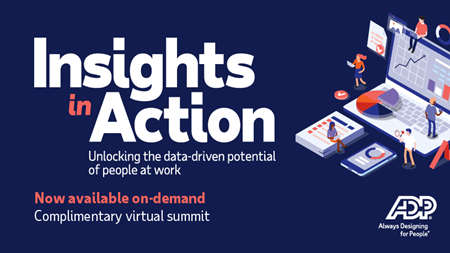How Generative AI Is Influencing the Future of Work
Part of a series | Insights in Action Series

Generative artificial intelligence (AI) tools are evolving quickly, as is their adoption in organizations in every industry. During our recent virtual summit, Insights in Action: Unlocking the Data-Driven Potential of People at Work, a panel of HR, data and technology experts discussed the considerations and ramifications of how organizations implement generative AI and the risks business leaders need to mitigate along the way.
During the recent ADP virtual summit, Insights in Action: Unlocking the Data-Driven Potential of People at Work, experts and leaders from various industries weighed in on key trends affecting work today, tomorrow and beyond.
One of the most engaging discussions of the event is a topic that has captured the attention of many people recently: generative AI. This technology is defined as AI that's capable of using a history of input and using models and algorithms to create all-new text, images and other content.
In a session called Generative AI and the Workplace of Tomorrow, a panel of HR, data and technology experts — Lyndsey Benson, vice president of HR; Steve Madden; Amin Venjara, chief data officer, ADP; and Jason Albert, global chief privacy officer, ADP — along with host Chip Cutter from The Wall Street Journal explore the relationship between this new technology and the future of work as we know it. Here are some key takeaways from the discussion.
Most organizations are considering how best to use generative AI
Exploration and education are at the heart of the current state of generative AI in the business world.
"Companies are trying to get a sense of what's really real with generative AI and where they can create tangible value for their customers and within their organizations," Venjara said.
Venjara added that business leaders today are prioritizing educational webinars and training, running pilot programs and exploring new vendor relationships. But introducing AI without guardrails could have some risks, so they're also creating policy frameworks that aim to ensure they're using this new technology in ways that are appropriate to their brands and safe for customers and associates.
"Education, pilots, and policy frameworks are all coming together to take the potential of generative AI and turn it into reality," Venjara said.
While the speed of adoption may be partly attributed to the excitement around new technology fueled by viral media attention, organizations using generative AI tools still need to recognize the unique responsibilities that come with early adoption.
Albert suggested some questions leaders should ask to guide their decisions around generative AI.
"First, ask: What use cases might this really help with? Where can it help me make things more efficient? Where can it help me generate content? Where can it help me sift through data and provide a more personalized human experience to my customers?"
Efficiency and customer experience, though, aren't the only priorities. Albert recommends that business leaders exploring potential AI use also ask, "How do I make sure I use this in a way that protects my company's data and individuals' privacy? How do I make sure that I protect my intellectual property and put in place the governance structure to allow me to take advantage of those benefits while still having those appropriate protections?" (Read: Generative AI at Work: Addressing Your Top Concerns)
Generative AI can offer multiple advantages in the workplace
The benefits of generative AI in the workplace are numerous. Organizations are continuously coming up with new use cases for the developing technology. Here are some of the potential key advantages:
Speed and efficiency
Generative AI tools offer ways to streamline processes, reduce administrative work and obtain data-informed insights faster than ever possible before. Saving time and effort can help teams do more with less, which is a crucial benefit for organizations with workers who can be freed up for other tasks that demand particular knowledge, creativity and innovation.
Data collection and analysis
Generative AI can help leaders gain insight into everything from buyer motivation to employee engagement. At Steve Madden, Benson said, team members are exploring how generative AI tools can improve the recruiting process by sorting high volumes of resumes. These tools can also help summarize and synthesize feedback from departing associates' exit interviews.
"There [are] capabilities with generative AI now where it could sift through some of the writing," Benson said, "where people put their comments about why they're leaving, and [generative AI can] give you the three key reasons why people are leaving."
She added that directly conversing with people remains a crucial element so that you don't lose the human touch, but generative AI can help you shape those conversations.
Streamlined processes and relief from repetitive tasks
Because these tools can help shoulder manual tasks, people become freer to invest time and energy in creativity and innovation.
"The goal is to make things easier," Venjara said. "Remove manual tasks and make the system proactive – knowing what needs to be done and doing it.
When you have this kind of virtual assistant that takes care of rote tasks and then gives you reports and reminders when you need to act, you can start at the next step and build on it.
Say the system flags for you that an employee has reached a milestone that deserves recognition. You can take that AI prompt and turn it into a more human acknowledgment.
"You can do the job that HR is meant to do," Venjara said, "which is to connect people, drive engagement, and foster a vibrant workplace culture."
Get our guide: Download "AI in HR: Five use cases you should know"
Ethics are a prime focus for early adopters
Organizations that have already adopted generative AI tools in the workplace are on the frontline in ensuring this new technology is used in alignment with their mission and values. The session panelists agree that organizations can benefit from supplementing an existing legal team by bringing in an AI ethicist or a lawyer with an AI specialty.
"AI is all about helping humans make better decisions and better predictions so we can take more impactful action," Albert said. "That's the first part. The second part is having thoughts about ethics and compliance and having a transparent ethics program where we're going to be transparent about where AI is going to be used."
The goal, Albert added, is to provide guidance to people so they understand how it works, where it's appropriate, where it isn't and the limitations of the system as well as having a security program in place to protect the data.
"The foundation of meaningful results," he said, "is having compliance, explainability and transparency so that clients have confidence in the overall approach that's taken in the development and operation of the systems."
Available on demand: Register for, then watch the full recording of this and other sessions from the Insights in Action summit on data and AI and learn even more about how technology and innovation are driving changes in the workplace.




